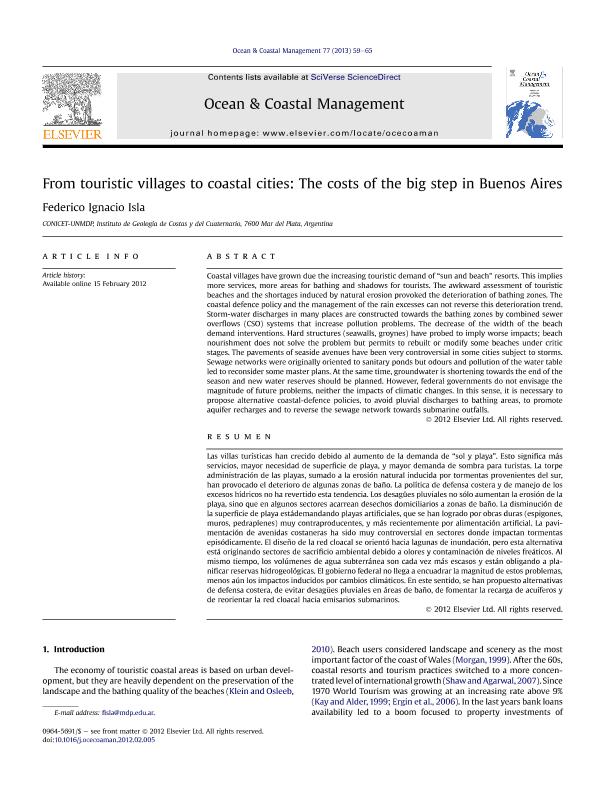Mostrar el registro sencillo del ítem
dc.contributor.author
Isla, Federico Ignacio

dc.date.available
2017-10-04T19:31:05Z
dc.date.issued
2013-02
dc.identifier.citation
Isla, Federico Ignacio; From touristic villages to coastal cities: The costs of the big step in Buenos Aires; Elsevier; Ocean & Coastal Management; 77; 2-2013; 59-65
dc.identifier.issn
0964-5691
dc.identifier.uri
http://hdl.handle.net/11336/25910
dc.description.abstract
Coastal villages have grown due the increasing touristic demand of “sun and beach” resorts. This implies more services, more areas for bathing and shadows for tourists. The awkward assessment of touristic beaches and the shortages induced by natural erosion provoked the deterioration of bathing zones. The coastal defence policy and the management of the rain excesses can not reverse this deterioration trend. Storm-water discharges in many places are constructed towards the bathing zones by combined sewer overflows (CSO) systems that increase pollution problems. The decrease of the width of the beach demand interventions. Hard structures (seawalls, groynes) have probed to imply worse impacts; beach nourishment does not solve the problem but permits to rebuilt or modify some beaches under critic stages. The pavements of seaside avenues have been very controversial in some cities subject to storms. Sewage networks were originally oriented to sanitary ponds but odours and pollution of the water table led to reconsider some master plans. At the same time, groundwater is shortening towards the end of the season and new water reserves should be planned. However, federal governments do not envisage the magnitude of future problems, neither the impacts of climatic changes. In this sense, it is necessary to propose alternative coastal-defence policies, to avoid pluvial discharges to bathing areas, to promote aquifer recharges and to reverse the sewage network towards submarine outfalls.
dc.description.abstract
Las villas turísticas han crecido debido al aumento de la demanda de “sol y playa”. Esto significa más servicios, mayor necesidad de superficie de playa, y mayor demanda de sombra para turistas. La torpe administración de las playas, sumado a la erosión natural inducida por tormentas provenientes del sur, han provocado el deterioro de algunas zonas de baño. La política de defensa costera y de manejo de los excesos hídricos no ha revertido esta tendencia. Los desagües pluviales no sólo aumentan la erosión de la playa, sino que en algunos sectores acarrean desechos domiciliarios a zonas de baño. La disminución de la superficie de playa estádemandando playas artificiales, que se han logrado por obras duras (espigones, muros, pedraplenes) muy contraproducentes, y más recientemente por alimentación artificial. La pavimentación de avenidas costaneras ha sido muy controversial en sectores donde impactan tormentas episódicamente. El diseño de la red cloacal se orientó hacia lagunas de inundación, pero esta alternativa está originando sectores de sacrificio ambiental debido a olores y contaminación de niveles freáticos. Al mismo tiempo, los volúmenes de agua subterránea son cada vez más escasos y están obligando a planificar reservas hidrogeológicas. El gobierno federal no llega a encuadrar la magnitud de estos problemas, menos aún los impactos inducidos por cambios climáticos. En este sentido, se han propuesto alternativas de defensa costera, de evitar desagües pluviales en áreas de baño, de fomentar la recarga de acuíferos y de reorientar la red cloacal hacia emisarios submarinos.
dc.format
application/pdf
dc.language.iso
eng
dc.publisher
Elsevier

dc.rights
info:eu-repo/semantics/openAccess
dc.rights.uri
https://creativecommons.org/licenses/by-nc-sa/2.5/ar/
dc.subject
Coastal Management
dc.subject
Storm-Water Outfalls
dc.subject
Urban Development
dc.subject
Buenos Aires
dc.subject.classification
Oceanografía, Hidrología, Recursos Hídricos

dc.subject.classification
Ciencias de la Tierra y relacionadas con el Medio Ambiente

dc.subject.classification
CIENCIAS NATURALES Y EXACTAS

dc.title
From touristic villages to coastal cities: The costs of the big step in Buenos Aires
dc.type
info:eu-repo/semantics/article
dc.type
info:ar-repo/semantics/artículo
dc.type
info:eu-repo/semantics/publishedVersion
dc.date.updated
2017-10-03T17:32:16Z
dc.journal.volume
77
dc.journal.pagination
59-65
dc.journal.pais
Países Bajos

dc.journal.ciudad
Amsterdam
dc.description.fil
Fil: Isla, Federico Ignacio. Universidad Nacional de Mar del Plata. Facultad de Ciencias Exactas y Naturales. Instituto de Geología de Costas y del Cuaternario. Provincia de Buenos Aires. Gobernación. Comisión de Investigaciones Científicas. Instituto de Geología de Costas y del Cuaternario; Argentina. Consejo Nacional de Investigaciones Científicas y Técnicas; Argentina
dc.journal.title
Ocean & Coastal Management

dc.relation.alternativeid
info:eu-repo/semantics/altIdentifier/doi/http://dx.doi.org/10.1016/j.ocecoaman.2012.02.005
dc.relation.alternativeid
info:eu-repo/semantics/altIdentifier/url/http://www.sciencedirect.com/science/article/pii/S0964569112000269
Archivos asociados
